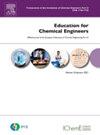Integrating CDIO framework into polymer engineering education: A hands-on approach to design, process, and evaluate biodegradable 3D printing filaments
IF 2.3
2区 教育学
Q1 EDUCATION, SCIENTIFIC DISCIPLINES
引用次数: 0
Abstract
This study introduces a hands-on polymer engineering curriculum integrating the Conceive-Design-Implement-Operate (CDIO) framework to bridge material design, processing, and evaluation of biodegradable 3D printing filaments. To address the brittleness of polylactic acid (PLA), students formulated PLA/poly (butylene succinate) (PBS) blends with an epoxy-based compatibilizer (ADR) and compounded pellets via twin-screw extrusion. Specimens for mechanical test were fabricated using an industrial-grade injection molding machine, with processing parameters guided by Moldex3D melt flow simulations. Continuous filaments (1.75 ± 0.05 mm diameter) were produced via single-screw extrusion with real-time filament diameter monitoring. The performance of the material formulations was evaluated through mechanical testing, rheological measurements, and assessment of the 3D printing quality. Students achieved successful filament printing in 100 % of cases (vs. <50 % in the prior year), attributed to simulation-aided parameter optimization, historical data sharing, and structured feedback mechanisms. Systematic analyses established the interplay between material formulation, processability, and mechanical properties. Evaluations of student performance demonstrated enhanced technical skills (27/34 students scored B or higher) and sustainability-driven problem-solving abilities. This curriculum bridges theoretical knowledge with industrial applications, offering a scalable model for sustainable engineering education.
将CDIO框架整合到聚合物工程教育中:设计、处理和评估可生物降解3D打印长丝的实践方法
本研究介绍了一个实践聚合物工程课程,整合了构思-设计-实施-操作(CDIO)框架,以桥梁材料设计,加工和评估可生物降解的3D打印长丝。为了解决聚乳酸(PLA)的脆性问题,学生们通过双螺杆挤出制备了PLA/聚丁二酸丁二烯(PBS)共混物,其中含有环氧基增容剂(ADR)和复合微球。采用工业级注塑机制作力学试验试样,并采用Moldex3D熔体流动模拟指导工艺参数。采用单螺杆挤压制得直径为1.75 ± 0.05 mm的连续丝,并实时监测丝径。通过机械测试、流变测量和3D打印质量评估来评估材料配方的性能。由于模拟辅助参数优化、历史数据共享和结构化反馈机制,学生们在100% %的案例中成功打印了灯丝(前一年为50% %)。系统分析确定了材料配方、可加工性和机械性能之间的相互作用。对学生表现的评估表明,他们的技术技能得到了提高(34名学生中有27名获得B或更高的分数),并具有可持续发展的解决问题能力。本课程将理论知识与工业应用相结合,为可持续工程教育提供可扩展的模式。
本文章由计算机程序翻译,如有差异,请以英文原文为准。
求助全文
约1分钟内获得全文
求助全文
来源期刊

Education for Chemical Engineers
Multiple-
CiteScore
8.80
自引率
17.90%
发文量
30
审稿时长
31 days
期刊介绍:
Education for Chemical Engineers was launched in 2006 with a remit to publisheducation research papers, resource reviews and teaching and learning notes. ECE is targeted at chemical engineering academics and educators, discussing the ongoingchanges and development in chemical engineering education. This international title publishes papers from around the world, creating a global network of chemical engineering academics. Papers demonstrating how educational research results can be applied to chemical engineering education are particularly welcome, as are the accounts of research work that brings new perspectives to established principles, highlighting unsolved problems or indicating direction for future research relevant to chemical engineering education. Core topic areas: -Assessment- Accreditation- Curriculum development and transformation- Design- Diversity- Distance education-- E-learning Entrepreneurship programs- Industry-academic linkages- Benchmarking- Lifelong learning- Multidisciplinary programs- Outreach from kindergarten to high school programs- Student recruitment and retention and transition programs- New technology- Problem-based learning- Social responsibility and professionalism- Teamwork- Web-based learning
 求助内容:
求助内容: 应助结果提醒方式:
应助结果提醒方式:


